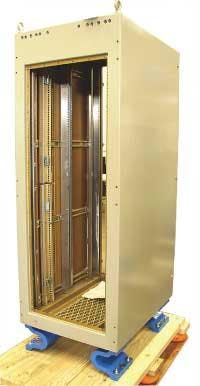by Ben Ames
AVONDALE, La. — The U.S. Navy's San Antonio-class (LPD 17) amphibious transport dock is the "21st century expeditionary warship," designed to shatter assumptions about the kinds of vessels that carry U.S. Marines into battle.
Instead of merely launching Marines into an immediate attack, it can host them for as long as six months. Instead of acting simply as a school bus to move people around, it can accommodate the Navy's "mobility triad" of Advanced Amphibious Assault Vehicles, Landing Craft Air Cushion, and the Marine Corps tilt-rotor MV-22 Osprey aircraft.
Sounds great, but wrapping all these goals into one ship will demand some sophisticated electronics. Electrorack Inc. of Anaheim, Calif., has an answer.
Electrorack enclosures will protect sensitive electronics on the U.S. Navy's San Antonio class amphibous transport dock.
null
Electrorack designers are working under terms of a contract from Raytheon to supply 19-inch ruggedized electronic enclosures to protect the LPD 17's sensitive electronic data network and control equipment.
Electrorack engineers have delivered enclosures for the first four ships in the new class. That includes 55 enclosures for the first ship alone, the USS San Antonio, which is under construction at Northrop Grumman Ship Systems in Avondale, La., near New Orleans.
Each aluminum enclosure weighs in empty at 300 pounds, and will hold as much as 600 pounds of electronics inside, says Jeff Shew, chief operating officer at Electrorack.
Electrorack specialists are capable of manufacturing rugged shipboard enclosures that meet MIL-S-901D for shipboard shock, MIL-STD-108E basic requirements for enclosures, MIL-STD-167-1 for mechanical vibration, and MIL-STD-810E for environmental extremes.
"The military now uses COTS electronics to reduce the cost of specialized, mil-spec hardware," Shew explains.
"To protect that COTS equipment, the burden now falls on the enclosures; they must be rugged and shock-isolated." COTS is short for commercial off the shelf.
So Electrorack designed the CEE (common equipment enclosure) to act as a single box capable of holding every different type of the ship's electronics. That worked fine until the Navy's dreaded "barge test."
To make sure the enclosure could hold up to a required 30-G impact, the Navy took it out to a barge, attached accelerometers, submerged it, and started dropping depth charges closer and closer; 40 feet, 30 feet, 20 feet, and 10 feet away.
Electrorack enclosures survived the 30-G impact provided by the U.S. Navy's explosive barge test.
null
Electrorack added stiffeners and designed a new type of polymer that works as a miniature shock absorber. "We're on the edge of state-of-the-art for shock-isolated cabinets," Shew says. "We're at the envelope of what's ever been done before."
Then they faced another challenge — how do you cool all the hot electronics inside such a tightly-sealed box? So Electrorack designed shrouded honeycomb filters, says Scott Shew, the company's general manager. "The trick with filters is to capture any electromagnetic radiation that would come out of the enclosure, but let air in, and keep water out," he says.
And finally, the Navy wanted each enclosure to be as small as possible, which gives almost no space for the shock absorbers to decelerate a blow. "We could have made them half the size of a cabin, and easily withstood the shock," Scott Shew says. "But the smaller space we do it in, the more usable equipment space they get in the ship. It's a tradeoff."
The enclosures hold navigation, guidance, fire control, and SWAN, the Navy's shipboard wide area network, which provides Internet and email access to every sailor's berth.
The San Antonio class has 12 ships, of which the first five are under contract for construction. When complete, the fleet will replace 41 existing vessels from outdated Austin-class amphibious transport docks, Anchorage- and Whidbey Island-class amphibious cargo ships, and Newport-class tank landing ships.


